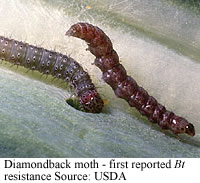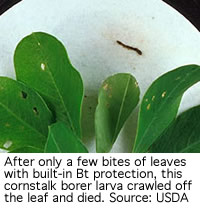 |
||||||||||||
Resistance
How do insects become resistant to pesticide?
Insects are known for their ability to develop resistance to insecticides. Currently there are insects resistant to every synthetic chemical insecticide used. There are many factors to developing resistance. In a population of insects there may be a few individuals that carry the genes for resistance. These genes arise from mutations and are rare. In the natural environment the mutant insect is typically compromised, weaker and produces less progenies. Upon exposure to insecticides, insects that do not carry the resistance genes die, thus allowing the individuals with the resistance genes to survive and reproduce, creating more resistant insects. With every generation the number of resistant insects increase.
Bt is a form of natural pesticide, as with any kind of pesticide the problem of resistance is almost unavoidable. Precaution must be taken and research must be done to understand and help prevent resistance with Bt.
Minimize Resistance
(Bt spray)
 There
are some steps Bt users apply to minimize resistance. Currently
in the field, the diamondback moth is the only insect found to have developed
resistance against Bt. The diamondback larvae feed on all plants
in the mustard family, including canola, mustard, broccoli, and cabbage.
The diamondback moth larvae is resistance to proteins made by the Bt
strain kurstaki.
There
are some steps Bt users apply to minimize resistance. Currently
in the field, the diamondback moth is the only insect found to have developed
resistance against Bt. The diamondback larvae feed on all plants
in the mustard family, including canola, mustard, broccoli, and cabbage.
The diamondback moth larvae is resistance to proteins made by the Bt
strain kurstaki.
In the laboratory, scientists have found many species
of insects to be resistant to Bt. These insects are currently
studied to further our understanding of Bt resistance and prevention.
Farmers that use Bt are required by the EPA to take steps to help prevent further resistance by other insects. Some alternate Bt applications with synthetic insecticides so that any resistance to any one class of insecticide does not develop.
Crop rotation is also another method used to help combat resistance. Since different crops are attacked by different insect pests, different types of Bt will be used. By rotating crops, the pressure of one specific strain of Bt on an insect is minimized. The pest insect has less time to develop resistance before a new strain is used for a different insect.
(Bt Transgenic Crop)
Farmers that use transgenic crops have to follow resistance management requirements set by the EPA. Refuge planting is a big part of resistance management in transgenic farming.